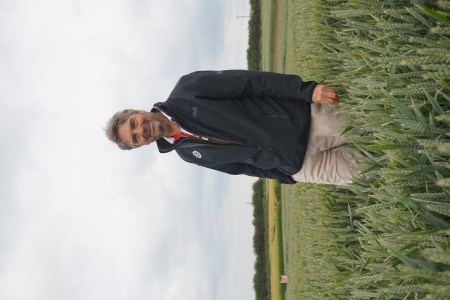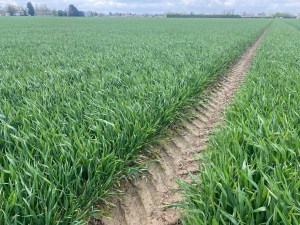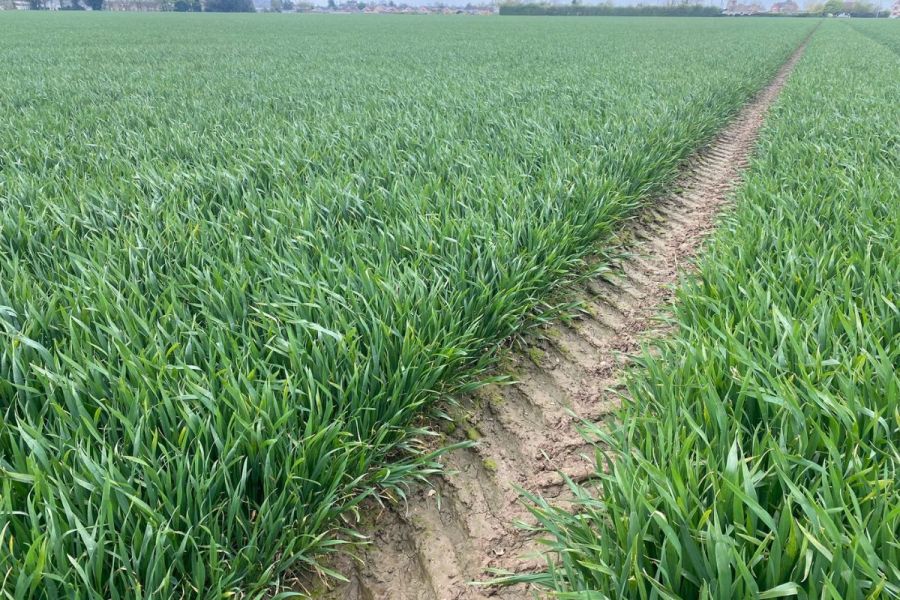An eye-catching variety for more than one reason, LG Redwald has the highest yields of any recommended wheat variety, but what makes it able to claim this crown and how do you get the best from the variety? CPM takes a closer look.
“Redwald is Sundance on steroids – it appears to be pretty robust and has good all-important septoria resistance.”
By Melanie Jenkins
Take a step back in time to the end of the sixth and start of the seventh centuries and King Rædwald ruled over East Anglia. Fast forward to 2023, and his namesake, LG Redwald, reigns supreme over AHDB’s Recommended List (RL) of winter wheat varieties, with its UK yield at 107% of controls.
A Group 4 soft wheat, Redwald has garnered attention for its consistency of performance as well as its yield, explains Limagrain’s Tom Barker. “Redwald has performed reliably, fulfilling its yield potential through National List to RL candidate trials, resulting in its recent RL approval.”
Redwald’s passage to recommended status has seen it perform across three quite different and difficult seasons. “We want to see varieties perform consistently in different growing seasons and in different regions, as this highlight’s an ability to cope in varying climatic situations. Redwald has achieved this,” says Limagrain’s Ron Granger.

From an agronomics point of view, Ron Granger recommends considering Redwald’s placement in the rotation, the sowing date and soil type to get the best from it.
The progeny of a cross between LG Sundance and LG Generation, Redwald yields 107% in the East, 109% in the West and a respectable 103% in the North, says Limagrain wheat breeder Phil Tailby. “Redwald’s large plant type and Septoria tritici resistance are inherited from LG Sundance, while Generation provides the additional yield and physical grain characteristics.”
Ron highlights the higher rainfall and septoria pressures in the West make Redwald’s performance in this area a real achievement. “Redwald is Sundance on steroids – it appears to be pretty robust and has good all-important septoria resistance – certainly a desirable characteristic for any variety grown in the West.”
According to Frontier’s Chris Piggott, Redwald is the only variety that has brought anything different to the RL this year. “The headline talking point is Redwald’s yield but when we look closer, it’s the variety’s western performance that’s most impressive because it sits quite clear of everything else.”
A characteristic of Redwald that’s sure to draw attention is its big, square and robust ear which seems to have more grain sites than in other varieties. As a possible consequence, the variety has a lower than desirable specific weight at 75.5kg/hl, points out Ron. “It’s acceptable, but growers must ensure full grain development is achieved from good husbandry programmes.”
To get that right, it’s important to understand the varieties characteristics and match the agronomy to them. As well as having a big biomass, Redwald is fast-developing in the autumn and generates a lot of tillers, adds Chris.
The new variety shouldn’t be planted on light soils that are prone to drought, says Ron. “It’s a later maturing variety with slower growth out of the spring, so it’s not really suitable for drought prone soils due to the risk of lower specific weight. The key is to grow the variety on water retentive soil types.”
Redwald yields well on heavier soil types and for those growing in these more fertile situations, a strong PGR programme is advised, adds Ron. “Looking at your soil type, yield potential, nitrogen applications and soil N are all important considerations. If you’ve had issues in the past with this type of variety, it’s fair to say it may not be the right variety for you.””

Redwald has big ears but it can produce grain with a relatively low specific weight of 75.5kg/hl.
Redwald scores 5s for lodging with and without a PGR, and it’s taller than LG Skyscraper and RGT Bairstow, says Ron. “Lodging is the concern, so it’s important to establish an agronomic programme to mitigate this risk.”
Limagrain implemented external trials work in 2021 with Scottish Agronomy to look at seed rates, N rates and PGR programmes, to determine their impact on Redwald.
The trial consisted of Redwald grown at two seed rates – a standard 375 seeds/m2 versus a lower seed rate of 275 seeds/m2, with two nitrogen rates of 180kgN/ha and 230kgN/ha. In addition, three different PGR programmes were implemented for comparison and a standard fungicide programme sprayed across all of the trial.
Ron says the results were very comparable with previous trials done on parent variety Sundance. “The main take home messages were that that higher N rates will determine higher yield potential in higher yielding varieties; reduced seed rates don’t adversely affect final yield potential and ensure better standing capabilities; and split PGR Programmes result in equal or better yield potential compared with a one hit PGR, as well as give better lodging resistance.
“The key was the PGR programme,” he adds. “I’m a huge believer in a split programme. To me, this will keep most varieties standing and, generally, has no negative effect on yield in big canopies.”
As seen in the trials, unsurprisingly seed rate is another defining factor for the big biomass variety. “Redwald is an absolute beast,” says Tom. “Because Redwald is such a high tillering, big biomass plant, it doesn’t have to be drilled at a high seed rate.”
In fact, lower seed rates may be advisable. Tom suggests a drop in seed rate of 15-20% could have no effect on yield performance while helping to keep the crop standing, and this was substantiated in the trial

Redwald’s large plant type and septoria resistance are inherited from LG Sundance, while Generation provides the additional yield and physical grain characteristics, explains Phil Tailby.
Reducing seed rate is a lesson learnt from Sundance, says Ron. “This was also a high tillering, big biomass variety and there were problems keeping it up. But we’ve learned from this and because Redwald is even bigger, we recommend reducing the seed rate.”
Limagrain also suggests that growers don’t drill Redwald too early. The recommendation is for it to go in from mid-October to the end of January, says Ron. “This variety isn’t suitable for the early drilling scenario – there are better varieties to choose, with the right combination of characteristics.”
Toby Reich of Wynnstay has seen Redwald planted behind oilseed rape, potatoes, maize and sugar beet. “These were all drilled between 5 October and 10 November, with seed rates reduced by 15%. The earlier planted crops are bigger and more substantial. Those drilled after the maize and root crops look perfect, so Redwald clearly suits the later drilling slot.
“There’s a risk some will plant Redwald earlier than is ideal and there’s a high chance they won’t get away with it,” he adds. “But it’ll be interesting to see if the lodging scores from official trials translate to a commercial situation.”
Chris agrees that Redwald suits later drilling. “You wouldn’t want to drill it too soon as this would exaggerate any issues with disease and lodging. It’s really important to pay attention to the growing guidance with this variety. In a late drilling situation, with correct PGR timing, Redwald is the highest yielding variety currently available.”
Another string to Redwald’s bow is its performance as a first and second wheat, says Chris. “It suits a second wheat position particularly well, sitting at 109%, a couple of percentage points above everything else on the RL.”
Looking at Redwald’s disease resistance, it has decent septoria (6.7) and brown rust (6) ratings, plus orange wheat blossom midge resistance. This comes out in its untreated yield figures, at 92% of control, says Tom.

Toby Reich is interested to see if Redwald’s lodging scores in official trials will translate into commercial situations.
“Untreated yield is becoming more important in variety trials as it highlights what the variety would be like in a worst-case scenario and also gives peace of mind to farmers if they can’t get onto the ground to spray crops at the ideal time.”
Chris feels that Redwald has a nice balance of disease resistance but admits that it’s susceptible to yellow rust at the seedling stage. “Overall, it’s certainly got an improved disease profile over some of the other widely grown feed wheats.”

Redwald has to compete with other good additions to AHDB’s Recommended List last year, but its comparison with them is great on paper, according to Chris Piggott.
Ron advises that Redwald should be monitored for juvenile yellow rust and a T0/T1 is advisable if the disease is present in the crop. “My view is that these newer yellow rust races should be kept out and a protective strategy used for this disease. I also advise that Redwald should receive a good T3 application as it’s a later maturing variety at +2. If you don’t apply a T3, the chances are the crop won’t achieve maximum grain fill.”
According to Phil, Redwald is a step forward in Limagrain’s breeding target to push yield boundaries, combined with improved grain characteristics and improved disease resistance in the feed sector. “We’re not just putting out single gene resistance but a robust package and we’ve more material coming through with combined resistances for higher levels of protection. We’ve got more tools than we had 5-10 years ago, so we can more efficiently combine and stack resistances earlier in the programme to create quantitative traits.”
Toby feels growers are spoilt for choice in terms of materials and varieties coming to market. “This is a good thing as it offers the opportunity to select a wheat variety based on your soil type, drilling situation, rotation, weather, pest, disease and weed pressures to help mitigate risk. Redwald is going to suit the professional grower, working on a large scale, who’s after a diversity in genetics and resistances.”
Taking a look at Redwald’s market prospects, Chris says the soft wheat market has been a challenging space recently. “We’re no longer in a situation where soft feeds have different market outlets, but this shouldn’t damage their appeal as they do perform well as feed wheats. Redwald also has to compete with the other good additions to the RL last year. But in comparison with them, Redwald is great on paper.”
Summing up, in a similar ilk to King Ræwald, the wheat variety is only going to reign over parts of the country. “Growers should look at the individual agronomic characteristics of the variety to decide if it suits their individual situation on farm. It will require managing, which is why we’ve written a short husbandry guide for growers on how to get the best out of the variety,” concludes Tom.
This article was taken from the latest issue of CPM. Read the article in full here.
For more articles like this, subscribe here.
Sign up for Crop Production Magazine’s FREE e-newsletter here.




